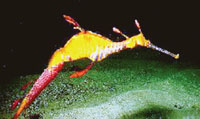
Dragons of the sea
Who isn't afraid of dragons, especially the fire-breathing creatures
we often hear of in legends and tales or see on television and movies?
However, the dragons featured here today are in no way capable of
sending you running for cover, in fear of your dear life even if you
encounter them, simply because, they are small in size and are not
breathing fire. And what's more, just to get a glimpse of these
frightful looking, but harmless dragons, you would have to go deep down
into the sea!

It may certainly take a while to fathom (understand) what these
weird-looking creatures are, but you will be amazed to learn that they
are the cousins of the tiny fish known as sea horses. Comparatively
large for sea horses, growing to around 18 inches or 45 cm in length,
Leafy Sea Dragons and Weedy Sea Dragons both belong to the family of
Syngnathidae (sin-nath-id-ee).
The Leafy Sea Dragon is the only member of the genus Phycodurus while
the Weedy Sea Dragon is the only member of the genus Phylloptery.
The general belief was that these are two different species, but
recent studies, have led scientists to believe that they may belong to
the same species in a wide range, from different territories.

The Leafy Sea Dragon is the official marine emblem of Southern
Australia. The Weedy Sea Dragon is the aquatic emblem of the State of
Victoria.
Spectacular and mysterious of all ocean fish, sea dragons resemble
floating pieces of seaweed and are generally found in temperate waters
in Western Australia, Southern Australia and the further east coast of
Victoria. They are found in cooler rocky reefs covered with kelp (large
seaweed), seaweed beds and seagrass beds in these regions and are
considered a rare type of fish.
In fact, as they are threatened with extinction, being preyed upon by
their worst enemy - the humans for their aquarium value, sea dragons are
now a protected species in Australia. Pollution too is destroying their
habitats and having an impact on their decreasing numbers.
Anatomy
Both species have streamlined bodies which are larger than their
cousins, the sea horses, with either leaf-like or weed-like
appendages(attachments). These appendages help these creatures to hide
from predators and also their prey.
If you look at the pictures featured here you will realize how
beautifully they blend with their environment with all the leaves and
weeds hanging from their bodies. The Leafy Sea Dragon certainly looks
like a normal sea horse that has got entangled in the plants found in
the sea bed!
The elongatedbodies of sea dragons are encased in a hard bony ring
series. They have small gill openings and are usually green to yellow in
colour.
What these dragons eat
Both Leafy Sea Dragons and Weedy Sea Dragons feed on plankton, algae
and flotsam. Larval fish and amphipods such as small shrimp-like
crustaceans known as mysids (sea life) are relished by these sea
dragons.
If you happen to notice their mouths, you are bound to wonder how
they eat with tube-like mouths that resemble drinking straws. Well,
these creatures simply slurp up their prey by the thousands as they move
about, camouflaged in the seaweed.
How they move about
Like their cousins the sea horses, sea dragons do not have prehensile
(gripping) tails. Their appendages and body are not used for movement
and steering at all. Steering is done by moving their tiny transulcent
fins along the sides of the head.
They are the pectoral fins visible above the head area. Propulsion is
done with the help of dorsal fins located along the spine. In fact,
watching them more could be a fascinating experience because those who
have done so claim that it seems as if an invisible hand is helping them
glide and tumble in peculiar, but graceful patterns, in slow motion.
Breeding
August-March is the normal breeding season. What's unique is that
like the male sea horses, male sea dragons too 'give birth' to their
young. But, unlike the sea horses, the dragons do not have 'brood
pouches' on their tails to hold the eggs.
Instead, they have 'brood patches' on the underside of their tails.
This part of the tail which is wrinkled consists of cups of blood-rich
tissue which can hold one egg each. The female lays around 250 eggs on
the male's tail which usually becomes slightly swollen, soft and spongy
during the breeding season.
The eggs are bright pink in colour and are incubated over a period of
4-6 weeks. Oxygen for the eggs are provided via the blood vessels in
each cup. Even though so many eggs are laid, not all the young survive.
Only about five per cent survive to maturity - that's two years.
The new-born dragons are not more than 2.5-3.5 cm in length and feed
initially on the yolk sac attached to them for the first two days. This
is because it takes two days for their snouts to grow! It is only after
the snout grows that they graduate to eating zooplankton.
The sea dragons are extremely fragile (delicate) creatures and are
difficult to maintain in captivity. They need a lot of care. So, don't
think of getting a sea dragon to live in a tank!
Anyway, these rare fish should be allowed to live peacefully in their
natural habitats where they belong and not in restricted, artificial
environments. Don't you think so too? |


